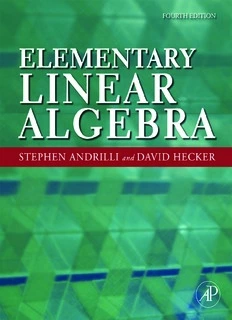
Elementary Linear Algebra, Fourth Edition PDF
Preview Elementary Linear Algebra, Fourth Edition
Elementary Linear Algebra Fourth Edition Stephen Andrilli Department of Mathematics and Computer Science La Salle University Philadelphia, PA David Hecker Department of Mathematics Saint Joseph’s University Philadelphia, PA AMSTERDAM•BOSTON•HEIDELBERG•LONDON NEWYORK•OXFORD•PARIS•SANDIEGO SANFRANCISCO•SINGAPORE•SYDNEY•TOKYO AcademicPressisanimprintofElsevier AcademicPressisanimprintofElsevier 30CorporateDrive,Suite400,Burlington,MA01803,USA 525BStreet,Suite1900,SanDiego,California92101-4495,USA 84Theobald’sRoad,LondonWC1X8RR,UK Copyright©2010ElsevierInc.Allrightsreserved. Nopartofthispublicationmaybereproducedortransmittedinanyformorbyanymeans,electronic ormechanical,includingphotocopy,recording,oranyinformationstorageandretrievalsystem, withoutpermissioninwritingfromthepublisher. PermissionsmaybesoughtdirectlyfromElsevier’sScience&TechnologyRightsDepartmentin Oxford,UK:phone:(+44)1865843830,fax:(+44)1865853333,e-mail:[email protected]. YoumayalsocompleteyourrequestonlineviatheElsevierhomepage(http://elsevier.com),by selecting“Support&Contact”then“CopyrightandPermission”andthen“ObtainingPermissions.” LibraryofCongressCataloging-in-PublicationData Applicationsubmitted. BritishLibraryCataloguing-in-PublicationData AcataloguerecordforthisbookisavailablefromtheBritishLibrary. ISBN:978-0-12-374751-8 ForinformationonallAcademicPresspublications visitourWebsiteat www.elsevierdirect.com PrintedinCanada 09 10 11 9 8 7 6 5 4 3 2 1 To our wives, Ene and Lyn, for all their help and encouragement Thispageintentionallyleftblank Contents PrefacefortheInstructor ........................................................... ix PrefacefortheStudent.............................................................. xix SymbolTable......................................................................... xxiii ComputationalandNumericalMethods,Applications............................ xxvii CHAPTER 1 Vectors and Matrices 1 1.1 FundamentalOperationswithVectors .................... 2 1.2 TheDotProduct............................................. 18 1.3 AnIntroductiontoProof Techniques ..................... 31 1.4 FundamentalOperationswithMatrices................... 48 1.5 MatrixMultiplication ....................................... 59 CHAPTER 2 Systems of Linear Equations 79 2.1 SolvingLinearSystemsUsingGaussianElimination ...... 79 2.2 Gauss-JordanRowReductionandReducedRow EchelonForm ............................................... 98 2.3 EquivalentSystems,Rank,andRowSpace................. 110 2.4 InversesofMatrices......................................... 125 CHAPTER 3 Determinants and Eigenvalues 143 3.1 IntroductiontoDeterminants.............................. 143 3.2 DeterminantsandRowReduction......................... 155 3.3 FurtherPropertiesoftheDeterminant.................... 165 3.4 EigenvaluesandDiagonalization........................... 178 CHAPTER 4 Finite Dime nsional Vector Spaces 203 4.1 IntroductiontoVectorSpaces.............................. 204 4.2 Subspaces.................................................... 215 4.3 Span.......................................................... 227 4.4 LinearIndependence ....................................... 239 4.5 BasisandDimension........................................ 255 4.6 ConstructingSpecialBases................................. 269 4.7 Coordinatization ............................................ 281 CHAPTER 5 Linear Transformations 305 5.1 IntroductiontoLinearTransformations.................... 306 5.2 TheMatrixofaLinearTransformation..................... 321 v vi Contents 5.3 TheDimensionTheorem ................................... 338 5.4 One-to-OneandOntoLinearTransformations ............ 350 5.5 Isomorphism ................................................ 356 5.6 DiagonalizationofLinearOperators....................... 371 CHAPTER 6 Orthogonality 397 6.1 OrthogonalBasesandtheGram-SchmidtProcess ........ 397 6.2 OrthogonalComplements.................................. 412 6.3 OrthogonalDiagonalization................................ 428 CHAPTER 7 Complex Vector Spaces and General Inner Products 445 7.1 Complexn-VectorsandMatrices .......................... 446 7.2 ComplexEigenvaluesandComplexEigenvectors........ 454 7.3 ComplexVectorSpaces..................................... 460 7.4 OrthogonalityinCn ........................................ 464 7.5 InnerProductSpaces....................................... 472 CHAPTER 8 Additional Applications 491 8.1 GraphTheory ............................................... 491 8.2 Ohm’sLaw................................................... 501 8.3 Least-SquaresPolynomials.................................. 504 8.4 MarkovChains .............................................. 512 8.5 HillSubstitution:AnIntroductiontoCodingTheory..... 525 8.6 ElementaryMatrices........................................ 530 8.7 RotationofAxesforConicSections ....................... 537 8.8 ComputerGraphics......................................... 544 8.9 DifferentialEquations....................................... 561 8.10 Least-SquaresSolutionsforInconsistentSystems......... 570 8.11 QuadraticForms ............................................ 578 CHAPTER 9 Numerical Methods 587 9.1 NumericalMethodsforSolvingSystems .................. 588 9.2 LDUDecomposition........................................ 600 9.3 ThePowerMethodforFindingEigenvalues............... 608 9.4 QRFactorization............................................ 615 9.5 SingularValueDecomposition ............................. 623 Appendix A Miscellaneous Proofs 645 ProofofTheorem1.14,Part(1)................................... 645 ProofofTheorem2.4.............................................. 646 ProofofTheorem2.9.............................................. 647 Contents vii ProofofTheorem3.3,Part(3),Case2............................ 648 ProofofTheorem5.29............................................. 649 ProofofTheorem6.18............................................. 650 Appendix B Functions 653 Functions:Domain,Codomain,andRange ....................... 653 One-to-OneandOntoFunctions.................................. 654 CompositionandInversesofFunctions.......................... 655 Appendix C Complex Numbers 661 Appendix D Answers to Selected Exercises 665 Index 725 Thispageintentionallyleftblank Preface for the Instructor Thistextbookisintendedforasophomore-orjunior-levelintroductorycourseinlinear algebra.Weassumethestudentshavehadatleastonecourseincalculus. PHILOSOPHY AND FEATURES OF THE TEXT Clarity of Presentation: We have striven for clarity and used straightforward lan- guagethroughoutthebook,occasionallysacrificingbrevityforclearandconvincing explanation. We hope you will encourage students to read the text deeply and thoroughly. Helpful Transition from Computation to Theory: In writing this text,our main intention was to address the fact that students invariably ran into trouble as the largely com- putational first half of most linear algebra courses gave way to a more theoretical secondhalf.Inparticular,manystudentsencountereddifficultieswhenabstractvector spacetopicswereintroduced.Accordingly,wehavetakengreatcaretohelpstudents master these important concepts.We consider the material in Sections 4.1 through 5.6 (vector spaces and subspaces,span,linear independence,basis and dimension, coordinatization,lineartransformations,kernelandrange,one-to-oneandontolinear transformations,isomorphism,diagonalizationoflinearoperators)tobethe“heart”of thislinearalgebratext. Emphasis on the Reading and Writing of Proofs: One reason that students have trouble with the more abstract material in linear algebra is that most textbooks contain few, ifany,guidelinesaboutreadingandwritingsimplemathematicalproofs.Thisbookis intendedtoremedythatsituation.Consequently,wehavestudentsworkingonproofs as quickly as possible. After a discussion of the basic properties of vectors, there is a special section (Section 1.3) on general proof techniques,with concrete exam- plesusingthematerialonvec torsfromSections1.1and1.2.Theearlyplacementof Section1.3helpstobuildthestudents’confidenceandgivesthemastrongfoundation inthereadingandwritingofproofs. We have written the proofs of theorems in the text in a careful manner to give studentsmodelsforwritingtheirownproofs.Weavoided“clever”or“sneaky”proofs, in which the last line suddenly produces“a rabbit out of a hat,”because such proofs invariablyfrustratestudents.Theyaregivennoinsightintothestrategyoftheproof or how the deductive process was used. In fact,such proofs tend to reinforce the students’mistakenbeliefthattheywillneverbecomecompetentintheartofwriting proofs.Inthistext,proofslongerthanoneparagraphareoftenwrittenina“top-down” manner,a concept borrowed from structured programming.A complex theorem is brokendownintoasecondaryseriesofresults,whichtogetheraresufficienttoprove theoriginaltheorem.Inthisway,thestudenthasaclearoutlineofthelogicalargument andcanmoreeasilyreproducetheproofifcalledontodoso. ix
Description: